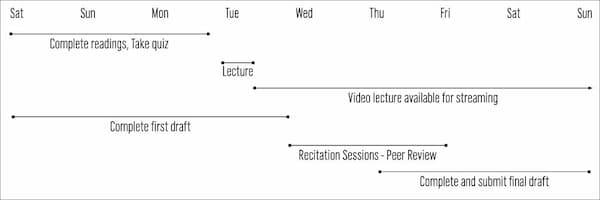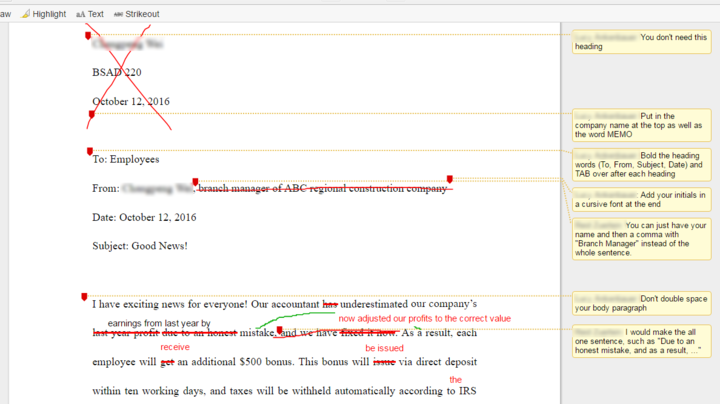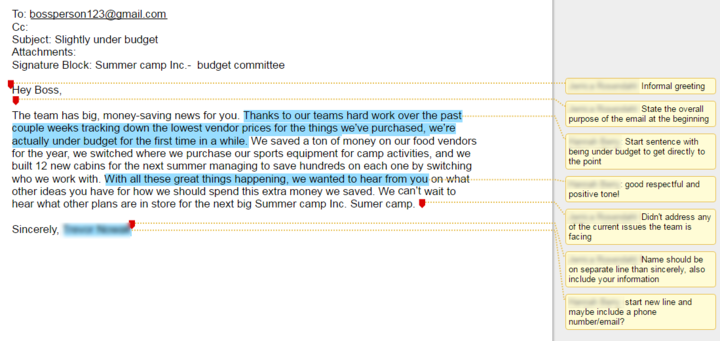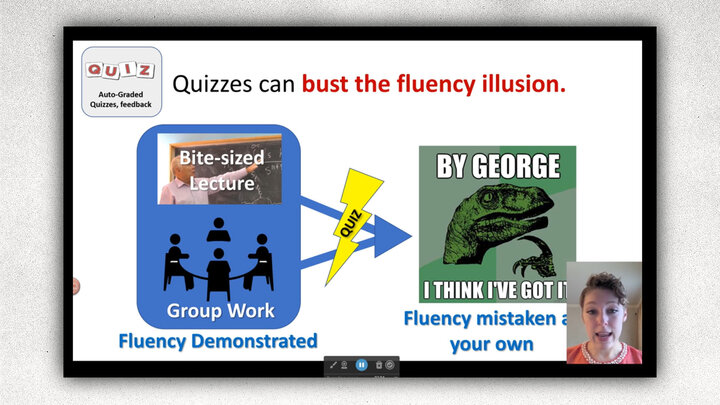Lead instructor Amber Messersmith delivers lectures, plans assignments, and coordinates a cadre of recitation instructors for BSAD 220 Business Writing, a large enrollment course with 400-500 sophomore students. The course, launched in Fall, 2016, is the foundation for writing across the College of Business Administration curriculum.
Messersmith had several goals for the initial semester of BSAD220. These included: transitioning to a new course format and LMS (Canvas), having clear organization throughout course components, achieving consistency in the facilitation of 13 recitation sections, and developing students’ skills in writing and critical thinking.
Course Design
A blended mode of instruction was adopted to give students the option of attending an in-person lecture or watching the recorded video later. Students sometimes do both. Narrated presentations and recorded lectures can be especially useful for international students and for using as content elements in flipped course designs.

The learning cycle begins on Friday of the previous week with students completing readings and a quiz before Monday’s lecture. After the lecture, students are expected to complete a first draft for peer review for their recitation sessions. Following peer review, students complete and submit their final drafts and begin the next week’s learning cycle.
Before the lecture, students are expected to have done the reading and taken a timed, open-book quiz through Canvas. After the lecture, they complete homework that will be addressed in one of the 13 recitation sections. Not every recitation session has a writing assignment, but those which do make use of peer review of first drafts. This helps students hone writing skills by having them both write and critique written work. Unlike most implementations of peer review that require students to review work online outside of class, students complete the peer review within Canvas in small groups during the recitation period. Not only does this simplify the management of the reviewers and eliminate all paper, it makes it possible for teachers to answer questions and clarify concepts. Most importantly, students get to discuss the feedback they received with the students who gave it to them. Messersmith believes students are more likely to take the process seriously when it’s done in class
“When students talk with each other it helps them understand the feedback more deeply and in context,” Messersmith said. “They also don’t rush through the review since they’re doing it in class,” she added.
The course has been a huge undertaking both from a content and assessment perspective as well as a technological one and Messersmith found the support provided by instructional designer, Steven Cain, to be invaluable.
“He’s been such a great help, from learning to use Canvas as well as giving me some perspective on the technology challenges we faced,” Messersmith said. “It would have been nice to phase it in, but we anticipated what we could and we’ve learned a lot,” she added.
Recitation
Recitation sessions are closely tied to the lecture and readings, offering an opportunity for students to apply what they’ve learned. Messersmith develops a common recitation curriculum that instructors facilitate in their respective sections.
Recitation instructor Elizabeth Vickers previously taught JGEN 220, a fully online course used to prepare business students for business writing before the creation of BSAD 220. She enjoys the face-to-face time and getting to know her students better. She teaches two sections with approximately 36 students in each.
Vickers said she spends a lot of her time grading, but the peer review helps with the load.
“[After peer review of the first draft] most of the errors are fixed, I can focus on content,” Vickers said.

Students use the built-in Crocodoc annotation tool to give feedback to their peers, and as John Geppert recommended in last month’s faculty feature, students are asked to give both positive feedback and specific critical feedback with suggestions for improvement.

Using a mouse, stylus, or touch-screen, Crocodoc allows for more free-form annotation.

Assignments include a variety of business communication formats from memos to emails, as well as strategies such as conveying bad news, addressing multiple audiences about the same topic, and condensing a long report down to a brief document.
Vickers also underscored the importance of Grammarly, a browser-based writing tool that takes context into account, thereby catching errors word-processor based tools do not. Because it is browser-based, it also checks social media posts and other content typed into web-based forms.
“They really like it and use it in other classes and on different platforms,” she said.
How to get Grammarly
The full version of Grammarly is currently restricted to College of Business only. Please see the sign-up FAQ in Canvas. Note you will need an access code from your instructor to activate it.
Mid-Semester Student Feedback
To get a sense of students’ perceptions of the peer review process, mid-semester feedback was sought and students were asked the degree to which they agreed with the following statement:
My writing has improved as a result of peer review during recitation class periods.
Of the 386 students who responded to this item, 65 percent agreed or strongly agreed, 19 percent neither agreed or disagreed, and only 16 percent disagreed or strongly disagreed.
Messersmith said there are some students who feel they should be able to test out of the course, but others who find it quite challenging. Qualitative responses on the same mid-semester survey suggested most students see the relevance of business writing to their future professional roles, and recognize they will be required to compose messages and documents like those in BSAD220.
Lessons Learned and Planned Modifications
One of the most critical lessons learned was the importance of clarity in instructions. There are numerous pieces to each writing assignment (requirements, multiple drafts, and due dates), which can pose interpretation challenges for students and instructors alike. While the goal from the outset was systematic simplicity, Messersmith and Cain have found ways to make changes for Spring 2017 that will enhance clarity. Some of these include changing submission instructions and introducing software tools in recitation, walking students through the tools rather than letting them experiment independently prior to class. The teaching team has agreed that simplicity from the student perspective outweighs simplicity and convenience for instructors.
Another important change for the spring term will be the timing and content of the quizzes. Instead of quizzing before the lecture about the readings, quizzes will follow the lecture and include items from the readings and the lecture. This should increase student accountability for the material, ultimately helping them gain more from the course. Presently, many students arrive at recitation not having viewed or attended the lecture. After discovering how many students weren’t attending lecture or viewing the videos, Messersmith began to modify course content such that information in the lecture is essential for succeeding with the assignments.
Overall, Messersmith, Vickers, and Cain feel the course is a success and look forward to refining it. In addition to the changes highlighted above, there are plans to include two sections developed for international students. Enrollment in these sections is entirely voluntary and non-international students are also welcome.
If you would like to know more about this course design or the technology used in the course, please contact Sydney Brown at sbrown3@unl.edu




